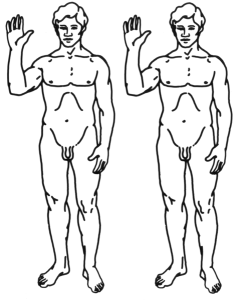With centuries of scientific experimentation, humans have certainly come a long way. We have learned a lot about the world around us. Of course, there is a lot more to learn, so the journey goes on. Today, we will be talking about crazy science that may actually take place in the distant future (or even sooner). This is the type of odd science that will absolutely blow your mind away.
Throughout the history of science, there have been plenty of controversial experiments performed. From the bizarre humanzee experiment conducted in the 1920s, to transplanting cells from a human into a mouse, we have definitely covered some very unusual and mind-boggling topics.
This article is based on extensive research on what may be coming in the future (hundreds or possibly thousands of years from now). This science may seem insane and controversial right now, but in the distant future, it may be perfectly acceptable. We will first start off with head transplants.
Human Head Transplants

“Vitruvian ORGWIN Head” by Orgwin is licensed under CC BY-SA 3.0
You have probably already heard the recent news about a possible human head transplant within two years. Dr. Sergio Canavero is a determined Italian neurosurgeon who has plans to make the procedure happen. He claims he is only a couple of years away from the very first total human head transplant. In fact, he already has his first patient lined up. The patient is a 30-year-old Russian man who is suffering from a very rare genetic disorder called Werdnig-Hoffman disease.
Canavero says he has been getting many emails and letters from people interested in getting the procedure done for themselves. However, not all of the emails are from people who are actually suffering from a disease. Some are coming from transsexuals who are looking for a new body.
The head transplant procedure could help people who are suffering from muscle and nerve degeneration. It can also help those with advanced stages of cancer. However, an ethicist says that instead of Canavero performing head transplants, he should be helping paralyzed patients walk.
Meet The Man Who May Be The First To Have Head Transplant Surgery
The Monkey Head Transplant Of 1970
Although Dr. Robert White was able to transplant the head of one monkey to the body of another back in 1970, the monkey had only survived for 8 days. This is because the body rejected the new head. The monkey wasn’t even able to move because the spinal cord of the head and body were not connected. This was not the only major complication. The other major complication was that the monkey was unable to breathe on its own. However, Canavero says that since the 1970s, advances in science and medicine have eliminated the problems that Dr. White had faced.
The Criticism And Skepticism Of Canavero’s Plan
Although Canavero insists his plan is going to work, many neuroscientists think the idea is too far-fetched. However, if you look at the history of science, you will find that many things that were thought to once be impossible and even laughable, eventually happened. For instance, if you were to go back to the 1920s and tell someone that man would be walking on the moon within a few decades, they would probably laugh at you. Of course, today there are plans to go even beyond the moon. The mission to mars is already in the works and man may go there in the 2030s.
Dr. Hunt Batjer is chairman of neurological surgery at UT Southwestern. He is also president-elect of the American Association of Neurological Surgeons. Batjer says that it is a huge leap to go from brain survival of the surgery to actually restoring body function. Although Batjer says the spine, major veins and arteries, and airway can all be put back together successfully, the major problem is the spinal cord. This problem can potentially result in the patient’s inability to move or even breathe.
Arthur Caplan is the director of medical ethics at NYU Langone Medical Center. Caplan is yet another man who is not in favor of Canavero’s future plans. He says that this whole head transplant idea is nothing but a big PR stunt. He even says that Canavero is crazy. Caplan believes that the procedure should be done on many animals before it is even considered to be performed on humans.
A Doctor Says Human Head Transplants Are Centuries Away
Dr. Robert Ruff is the Veterans Affairs national director for neurology. Ruff believes a human head transplant is not a couple of years away, but more like centuries away. Although Canavero is aware that there are still obstacles (such as funding and the need for a major academic medical center) and challenges with the procedure in general, he insists it can be done successfully in two years.
How The Procedure Will Work
When Was The First Successful Transplant On A Human?
The first successful transplant on a human was in 1905. Austrian ophthalmologist Eduard Zirm performed a corneal transplant. The surgery was performed on a man who had previously been blinded. Interestingly, it took nearly a century of experiments with animals to make it a success.
Human Cloning

“Human Clones” by Cherry is licensed under CC BY-SA 3.0
Human cloning is defined as the creation of a genetically identical copy of a human. The term is also used to refer to artificial human cloning, which is the reproduction of human cells and tissue.
Cloning is a method that has already been discussed as a possible option for bringing extinct species back. Is it possible to clone a human being? According to the experts, it is likely biologically possible to clone a human. There hasn’t yet been any confirmed human clone created. However, scientists have already cloned human embryos that are capable of producing embryonic stem cells.
What Is Preventing Human Cloning?
Today’s obstacle preventing human cloning is the fact that it is considered to be unethical. Even if ethics was not an obstacle, there are issues such as a vast amount of resources needed to make it possible. Since the 1950s, scientists have cloned dozens of animal species. This includes mice, cats, pigs, cows and sheep. However, in each case, there were difficult problems the researchers had to defeat. Due to the high rate of death and the risk of developmental abnormalities, cloning humans is considered unethical. However, in the distant future, it may be accepted and even practiced.
Resurrecting The Dead

According to critical care physician Sam Parnia, resuscitation research is on its way to a major breakthrough. Parnia says it is not hundreds of years away, but within the next 20 years.
With the medicine available today, after a patient’s heart stops beating and they have died from circulatory failure, people can be brought back to life up to around 2 hours or a little longer. Parnia claims that in the future, physicians will get much better at reversing death. He believes that we are only 20 years away from being able to restore people to life up to a day after they have died.
Cryonics: Bringing Back Those Who Are Long Gone
It may soon be possible to resuscitate someone up to 24 hours after their death, but what about those who are long gone? Can we bring our deceased loved ones back? According to scientists who perform cryonics, humans may someday be brought back to life (even after they are long gone).
Cryonics is the practice of deep-freezing the bodies of humans who have died from an incurable disease. The hope is that they might be preserved until future medical technology can restore them to full health. However, many critics say the companies are just ripping off their customers and giving them false hope of becoming immortal. They say cryonics will not deliver. The scientists who perform cryonics say they have yet to revive even one person since it was first proposed in 1962. Since 2013, approximately 270 people have undergone cryopreservation procedures.
What Is The Largest Obstacle For The Success Of Cryonics?
The scientists who perform cryonics do not expect to have the ability to revive anyone anytime soon. The biggest problem is that if the warming process is not done at exactly the right speed and temperature, the cells could form ice crystals and shatter. However, future technology may make it possible. Even with today’s available technology, scientists can freeze human embryos in fertility clinics. Then the embryo is defrosted and implanted in a mother’s uterus. Amazingly, the babies are born perfectly normal. In hundreds of years, will cryonics work? Of course, only time will tell.
Ted Williams: The Best Known Cryopreserved Patient

Building A Planet From Scratch

But have you ever wondered if scientists could actually make a planet? After all, since it is crucial for the human race to eventually spread out into space, why work on developing the technology for interstellar space travel? Instead of traveling light-years to find the nearest Earth-like planet, you can just create a planet that is a lot closer to the Earth. Perhaps we are centuries away.
According to Ask A Mathematician, in theory, there is nothing standing in the way. The physicist from the website says that if you were to construct a planet from dust, asteroids or comets, you can expect to get a fair amount of energy back out. Bellow is a video with interesting speculations.
Conclusion
What seems impossible to achieve today, may one day become a reality. As science continues to progress, there will be a lot more discoveries that could possibly change the world. Although some of the experiments may be completely accepted by society, others may actually be looked at as controversial, completely insane or even immoral. However, this will not stop those curious and determined scientists from continuing to conduct their strange and crazy science experiments.


